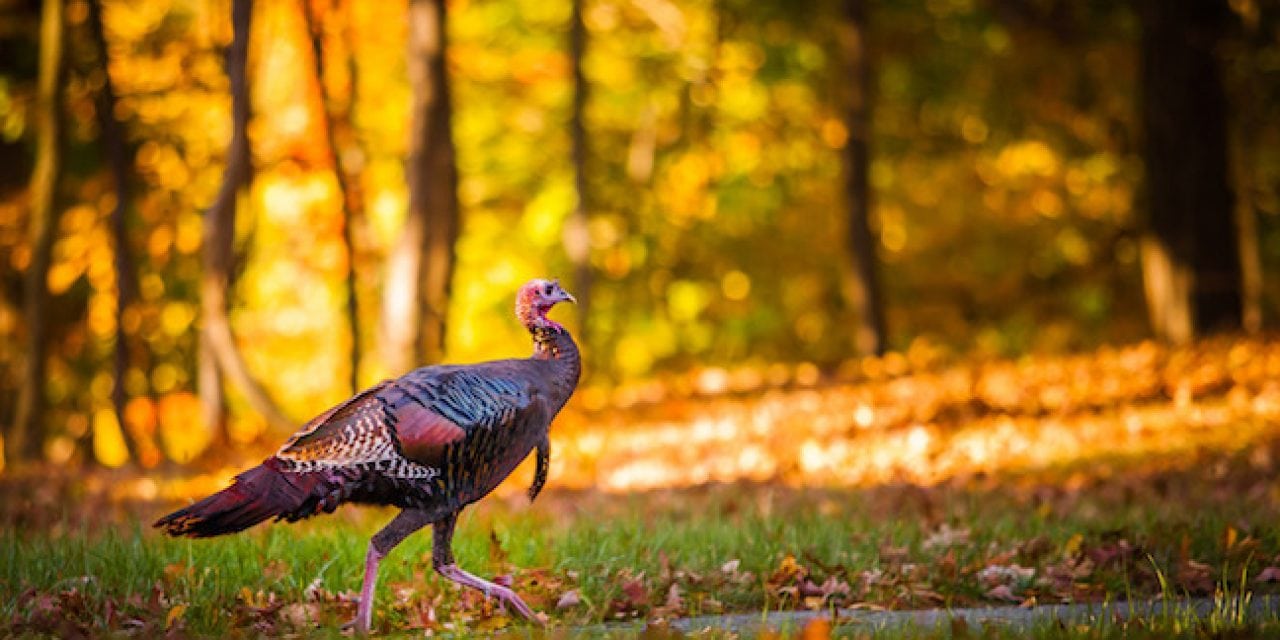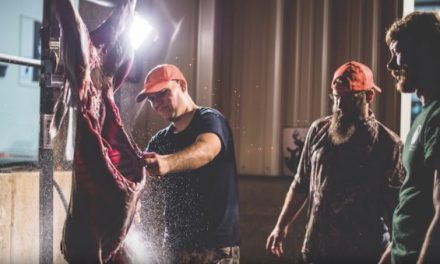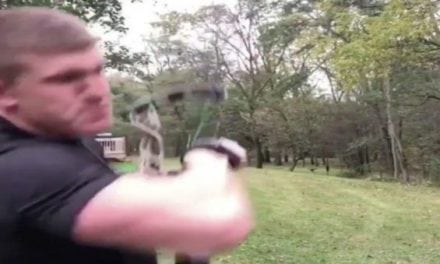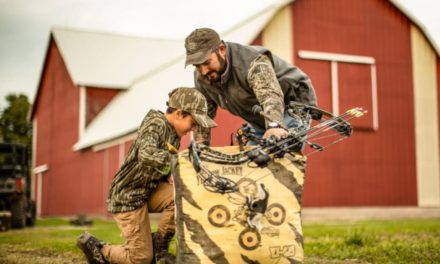This year, don’t miss the chance for some great fall turkey hunting in the Buckeye State.
The Buckeye State has plenty to offer the fall hunter. From trophy-class bucks to excellent waterfowl opportunities, the mix is impressive.
While perhaps not as popular as other species, particularly in the fall, wild turkeys are also a big part of the picture.
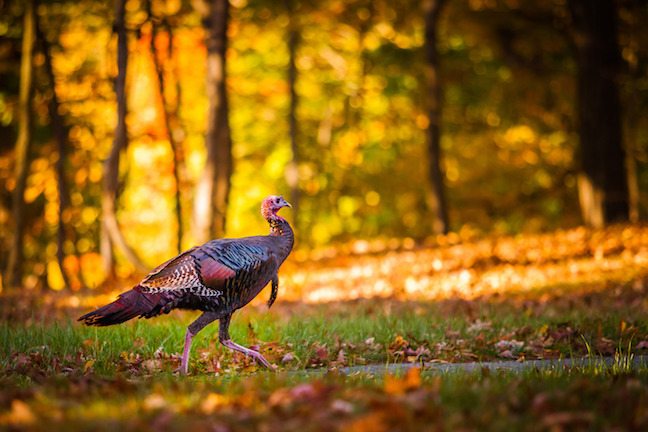
Shutterstock image
Ohio’s fall turkey harvest has run from about 1,000 to 1,500 birds in recent years.
In 2015, the most recent year harvest statistics were available at the time of this writing, the take was 1,535, the highest since 2,009, and a 24 percent increase over 2014.
Adult hens make up much of the fall Ohio harvest.
In 2015, 45 percent of the take was of adult females. Adult males accounted for 28 percent of the harvest, with juvenile females and juvenile males contributing 15 and 12 percent respectively.
Though the final 2017 hunting seasons were not yet set at the time of this writing, in all likelihood hunters can expect a similar season structure as last year, when 56 counties were open for fall hunting during a seven-week season that ran from the second week in October until late November.
Be sure to consult your 2017 Hunting and Trapping Regulations booklet for exact details on seasons and bag limits.
Harvest reports in the past indicate that the fall’s harvest is well-distributed throughout the season, though it’s tilted somewhat to opening week. And while many wild turkeys are taken by hunters specifically hunting them, many are also bagged by archers, suggesting that they offer targets to turkey-permit-holding deer bowhunters.
The top fall wild turkey producing counties in 2015 were Ashtabula (73), Hocking (52), Gallia (50), Trumbull (50) and Geauga (45).
Here is a look around the state at some of the better fall turkey hunting options this year as well as some timely tips to help you bag a bird this fall.
Bull-Eye’s for Turkeys
Call District 1 the bull’s-eye of the Buckeye State. Situated smack dab in the middle of the state, the area is better known for state government and Big Ten football than it is for wild turkey hunting.
But good opportunities are present for hunters from this part of the state.
District 1 has a history of a good turkey population, but the habitat is pretty broken up. And not all the counties in this district are open to fall hunting. Basically, those west of Morrow, Delaware and Franklin are closed.
This is central Ohio, centered around the capital of Columbus. Primarily it’s private land. Hunters are going to have to work harder to get permission to hunt, but those who can get permission should find birds.
Several District 1 counties had significant fall harvests in 2015. They included Knox with 44 and Licking with a take of 22. Not surprisingly, the largest harvests took place in the eastern portion of the district.
Expanding Opportunities
Much of the hunting attention in District 2 focuses on the abundant waterfowl options the district provides. Indeed, the marshlands associated with Lake Erie provide excellent sport.
But the hunting isn’t limited to ducks and geese.
There are expanding hunting opportunities for birds of a different feather — the wild turkey. Only two counties in District 2 are open to fall hunting: Williams and Defiance, which produced 18 and 20 wild turkeys, respectively, during the 2015 season.
The counties in District 2, in northwestern Ohio, average only about 15 percent forested cover, and turkey abundance here is the lowest in the five districts of the state. But the turkey populations here are also growing more rapidly than in any other district.
Many of the wildlife areas in District 2 are marshlands. Some upland area is present, however. In Williams County consider the Beaver Creek Wildlife Area. Oxbow Lake Wildlife Area is Defiance County.
But often the key to success in this district is to do your homework and get permission to hunt forested private land areas.
Contact the District 2 office at 419-424-5000 for more information on the hunting in this area.
Don’t Venture Far
District 3, in the northeast portion of the state, contains some of the stronger wild turkey populations in Ohio.
This serves many hunters well, as the area also houses major population centers like Cleveland, Akron and Youngstown.
These sportsmen don’t have to venture far to find excellent wild turkey hunting.
There are turkeys for hunters to find in District 3. It is one of Ohio’s stronger districts. Turkeys have been there for a long time. You can move anywhere in District 3, from the northeast corner, in Ashtabula County, all the way down to Jefferson County and Harrison County and you are going to find good numbers of birds. Columbiana County is also a good one. District 3 also has a good mix of both public-land hunting opportunities and private land.
Several counties in District 3 have a strong history of producing good wild turkey harvests, including Ashtabula, where 73 birds were taken in 2015. Harrison County produced a harvest of 32. Tuscarawas County hunters bagged 23 the same season.
Much of District 3 is made up of a mix of forestland and agricultural land. The areas in Trumbull County are rich in such makeup. During the fall of 2015 50 birds were taken from that county. It’s an area worth the effort to find private lands to hunt. The region has many state-owned wildlife areas that contain upland forested habitat. This includes Grand River Wildlife Area, which features nearly 7,500 acres of public hunting area, a good portion of which exists as uplands favorable to wild turkeys.
Contact the District 3 office in Akron at 330-644-2293 for more information.
Cream of the Crop for Wild Turkeys
Southeastern Ohio’s District 4 is the cream-of-the-crop in terms of the state’s wild turkeys. From the rugged, forested hills that lie along the Ohio River in the eastern portion of the district to the agricultural lands to the west, there is an abundance of wild turkey habitat in this district.
Add to that the plethora of former strip-mined areas (places that are now reverting to forested cover of various life stages), and you have a lot of options to choose from.
District 4 probably has more turkeys than any other district in the state. Turkeys have been there the longest. It is where all the reintroduction and reestablishment of turkeys in the state began. Every county has good numbers of birds; they are very well distributed.
District 4, by far, also has the most public land opportunities of any district in the state, thanks in large part to the Wayne National Forest, state forests and wildlife areas.
Athens County accounted for 31 wild turkeys in 2015; 33 birds were taken in Belmont County. Coshocton County, in the western portion of the district, saw a harvest of 43 birds. Guernsey County hunters put tags on 35 wild turkeys, while 43 did the same in Jackson County. Meigs County, as usual, had a significant fall harvest with 33 wild birds being taken.
Wayne National Forest provides the most extensive public hunting area in District 4, covering over 800,000 acres. The public land exists in three separate units, and is found in 12 different counties.
Additional information can be obtained by phoning the District 4 office in Athens at 740-594-2211.
Blend of Habitats
District 5 contains a blend of habitats, from the Ohio River valley counties to the south to the flatlands to the north. In between you’ll find urban areas such as Dayton. Only a portion of the counties in District 5 are open to fall hunting, however (basically ones in its southern region).
Wild turkeys in the district have a good mix of the heavily forested counties like Adams and Highland. But when you move into the western part of the district, such as in Ross County, things begin to get more broken up by agricultural and urban areas.
Most of the counties in District 5, though, especially the northern and western counties of the district, will have more limited wild turkey distribution. Most of the birds are on private land, so access and permission to hunt is a factor there. It may take a little more planning and a little more time to set up a hunt in that part of the state.
Last year Clermont County, found in the southern portion of the district, had one of the state’s better fall harvests, with 43 birds bagged there in 2015.
The district does contain some extensive public lands, mostly in the southern portion, such as Shawnee State Forest.
FALL TURKEY HUNTING TIPS
For the past 31 autumns, turkey hunting enthusiast Joanie Haidle has roamed the woods, fully immersed in the challenge of fall turkey hunting. She’ll be out there again this fall, using the well-earned tools of patience and persistence to her advantage.
Haidle, who makes “Joanie’s Beard Bustin’ Turkey Calls,” sees impatience as a shortcoming of many fall turkey hunters. Her approach, especially during the early hours of a fall hunt, is more laid-back.
Since she hunts with a shotgun, her methods are geared toward getting a bird within range of her 12-gauge Mossberg.
“What I like to do in the fall, the first thing in the morning, is to get into an area that I know turkeys frequent — roosting sites, oak ridges, grape vines — and I simply set up and I’ll call,” Haidle explained. “I don’t necessarily need to locate their exact position, just as long as I feel they are within hearing distance.”
Haidle says turkeys are quite vocal in the fall, especially when it comes to a hen keeping track of her young flock. So Haidle is constantly alert for their chatter, which is proof-positive she’s in a prime area.
And while a classic fall tactic is one of breaking up a turkey flock and then attempting to get a quality shot by calling to the scattered birds as they regroup (and that’s a tactic she often employs), Haidle has found she can attract a hen without the busting maneuver.
“I try to get the attention of the hen,” Haidle said. “She can’t count her poults. So, she’ll feel there’s one out there that is lost and will come looking for it. I’ve done this many times, often calling in the whole flock. But it can take hours. That’s where patience and persistence comes in.”
When trying to locate a turkey flock in the fall, Haidle often slowly walks the oak ridges, listening not only for their vocalizations, but feeding sounds as well.
“I really like those dry fall days, ones when the leaves are noisy,” she noted. “I’ll work along a ridge, calling, and really listening. Many times, you’ll pick up their scratching through the leaves while they are feeding on acorns.”
When this situation presents itself, Haidle determines the direction the flock is heading. Then she circles around ahead of them and begins calling — often starting off with a kee-kee run — a tactic that typically gets a positive response.
Regarding calling strategies, Haidle likes to stay active during fall hunts. While the judicious use of a call in the spring — just enough to keep a gobbler interested — is often appropriate, it’s a different circumstance in the fall.
“The turkeys are very talkative in the fall,” she observed. “The young poults, during the morning, make a bunch of racket. They are kee-keeing, they’re yelping.”
Haidle’s turkey calling is typically done with one of her mouth calls, a diagram call named the Terminator. It’s a three-reed call with a ghost cut, and the one she prefers for making the kee-kee run, the lost whistle made by young turkeys during the fall and winter.
Haidle said her fall strategies are also influenced by the makeup of the turkey groups being hunted, since individual flocks can be made up of hens with poults, grouped-up hens, and gobbler flocks. The latter provides the biggest challenge in the fall. But she’s had success bringing in mature gobblers, simply issuing simple gobbler yelps and clucks made with a box call, her favorite being a Ben Lee Gobble Box.
“I like to hunt whatever comes in,” Haidle said. “But it’s always a plus when a nice gobbler comes in during the fall. I’ve had a few opportunities, when I was able to harvest a nice adult gobbler, which is a rarity in the fall.”
The post Ohio’s Fall Turkey Hunting Outlook appeared first on Game & Fish.

